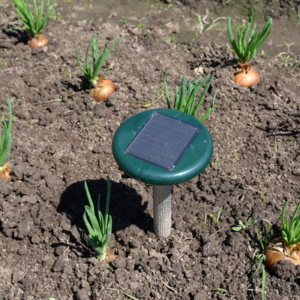Don’t Allow Moles to Wreak Havoc on Your Georgia Lawn
Moles
Are you noticing mounds of dirt piling up in your backyard? Are tunnels beginning to form out of nowhere, uprooting dirt and compounding piles? No, most likely, there was not a small earthquake on your Georgia landscape. It is possible, however, that you may have a mole problem. Moles are small mammals that spend most of their time living underground. During the springtime, they begin actively searching for food, bringing them closer to the surface of your lawn. In doing so, they can wreak havoc on your turf and cause tons of damage to your grass. In this article, we teach you the symptoms of a mole infestation and what to do when a mole problem occurs.

Why Are Moles Bad for My Lawn?
Moles can consume their entire body weight worth of food every day. They are constantly on the hunt for dinner, and their unsavory diet consists of earthworms, grubs, ants, and other insects that burrow in your grass. They can move quite rapidly through the soil, which inadvertently can cause a disturbance in your grassroots, causing immediate damage. One mole can dig up to 100 feet of tunnel in one day. That’s a lot of coverage! Suddenly the old saying, “don’t make a mountain out of a molehill,” makes perfect sense.
There Are Two Types of Moles That Live in Georgia
They are the star-nosed mole, which is more common here in Northern Georgia, and the eastern mole found throughout the state. Both types have very sensitive snouts and long claws. The eastern mole has dense fur that sticks straight up, while the star-nosed mole’s fur lays flat and points toward the tail.
How Can I Tell if I Have a Mole Infestation?
First, you will notice one of two things happening throughout your yard. You will have what is referred to as molehills, or you will have raised edges.
Molehills
As mentioned above, when moles are foraging for food, the surface around the tunnels becomes raised, creating molehills. These often appear in the shape of a volcano. Often the raised soil will feel soft and spongy when you walk on it.
Raised Edges
Some moles do their tunneling deeper in the ground. If this is the case, you may notice a raised edge of either soil or grass instead of molehills.
Moles Can Be a Sign of Other Problems
While not always the case, if mole activity is abundant in your Georgia lawn, this could be a sign of another problem. Moles need quite a bit of food to survive, so if they are invading your yard, you probably have mass amounts of surface lawn pests. One of these pests is grubs. Moles enjoy the taste of these critters, so your first step is to determine if you have a grub problem. Grubs are the larvae of the scarab and other beetles and borrow deep inside your grass and lay their eggs. Once hatched, they feed on the roots of your grass. They, too, can cause massive destruction. Between the two, your landscape is liable to start looking like a post-apocalyptic war zone. But there is hope. There are ways to eliminate moles from wreaking havoc on your lawn. And we have the answers.
Ways to Eliminate Moles From Your Georgia Lawn
Mole Traps
If you are looking for do-it-yourself methods, the most popular way to eliminate moles is through trapping. There are several different types of traps, so be sure you read the labels and set them up properly. Live trapping by setting a deep bucket under an active tunnel is sometimes effective. To do this, set up a live trap, and dig a hole at the end of the tunnel. Make sure it is deep enough to place inside a two to a five-gallon bucket. Pack the dirt around the edge of the bucket and cover the hole with sod or plywood. The mole will fall in, and you can safely remove it and take it to a new location. Trapping moles can be challenging and difficult because you have to know precisely where to place them. We recommend hiring a professional mole trapper who is trained, knowledgeable, and feels comfortable handling live animals.
Plants that Moles Hate
Like most living creatures, there are certain smells that moles can’t stand. Plant a few of the following around your property to help keep the moles away.
- Marigolds
- Daffodils
- Jack-in-the-Pulpit
- Crown Imperial
- Salvia
- Irises
- Castor Bean
- Euphorbia lathyris
These plants may help, but their effects are localized and may only keep the moles away from the area surrounding the plant.

Use the Power of Noise and Vibration
Moles use their sense of hearing to hunt. This means they are susceptible to loud noises and vibrations. Home goods and garden stores sell ultrasonic devices that emit irritating sounds, vibrations, and odors undetectable by humans but picked up by moles. Most are powered by solar energy and do not require applications or attention.
Let the Professionals Handle It. Contact Progressive Pest About Our Mole Treatment Service
Does all of this sound like a lot of work? It probably is, not to mention time-consuming. And unless you want to risk more damage to your lawn, we suggest leaving mole removal up to the experts. Progressive Pest has you covered. We offer an effective mole treatment service. We will apply bait to your entire yard and rid your landscape of these destructive creatures. Don’t waste time and energy trying to handle your mole problem on your own. Contact Progressive Pest now. Call (706) 654-2730 or reach out to us here. And check out our other blog articles for more tips and ideas on controlling pests both inside your property and around.

